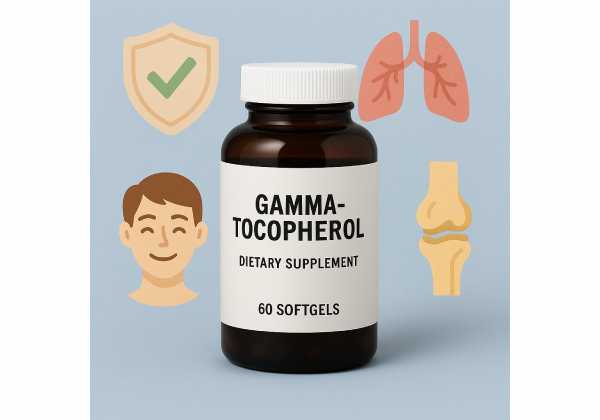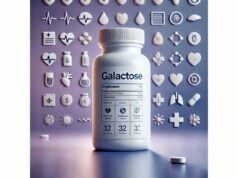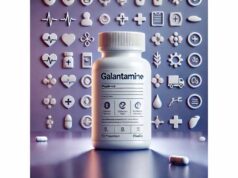
Gamma-tocopherol is a major dietary form of vitamin E found in many everyday foods, especially soybean, canola, and corn oils, as well as certain nuts and seeds. Unlike alpha-tocopherol—the form used to set recommended intakes—gamma-tocopherol has unique chemistry that helps trap reactive nitrogen species formed during inflammation. Interest has grown around whether this form supports respiratory health, offsets oxidative stress from pollution or exercise, and complements a balanced intake of mixed tocopherols. This guide explains what gamma-tocopherol is, how it might work, what the human evidence actually shows, how to use supplements (if appropriate), and who should avoid them. You’ll also find clear, practical dosing ranges used in research, common mistakes to sidestep (like taking high-dose alpha-tocopherol alone), and safety guardrails so you can have an informed discussion with your clinician.
Essential Insights
- May help temper airway inflammation and support antioxidant defenses in short-term trials.
- Avoid relying on vitamin E alone for disease prevention; benefits are context-specific and evidence is mixed.
- Common research doses: 400–1,200 mg/day of γ-tocopherol for 1–2 weeks; take with food.
- Individuals on anticoagulants, with bleeding disorders, or scheduled for surgery should avoid unsupervised high-dose vitamin E.
Table of Contents
- What is gamma-tocopherol?
- Does it work: key benefits and mechanisms
- How to take it correctly
- How much gamma-tocopherol per day?
- Common mistakes and interactions
- Safety: who should avoid it
- Research summary in humans
What is gamma-tocopherol?
Gamma-tocopherol (γ-tocopherol) is one of the eight molecules that make up the vitamin E family (four tocopherols and four tocotrienols: alpha, beta, gamma, and delta). In North American diets, gamma-tocopherol is often the predominant tocopherol because it is abundant in commonly used vegetable oils and certain nuts and seeds. In contrast, alpha-tocopherol (α-tocopherol) is the primary form the body retains and uses to establish recommended intakes.
A key difference between gamma and alpha is chemical. Gamma-tocopherol has an unsubstituted position on its chromanol ring that can react with electrophiles and reactive nitrogen species (RNS) such as peroxynitrite. That enables gamma-tocopherol to “trap” nitrating oxidants and form stable by-products. It still behaves as a classic lipid-phase antioxidant, but its anti-nitrosative activity sets it apart.
Your liver’s alpha-tocopherol transfer protein (α-TTP) preferentially selects α-tocopherol for recirculation, which explains why blood levels of α tend to be higher than γ even when diets contain more γ. This preference also means that very high supplemental intakes of α-tocopherol can lower circulating γ-tocopherol by increasing its metabolism and elimination. Practically, many “vitamin E” products supply only α-tocopherol; others contain “mixed tocopherols” with meaningful amounts of γ (and sometimes δ) to better reflect food patterns.
Food sources of γ-tocopherol include soybean, canola, and corn oils; walnuts, pecans, pistachios; and sesame and flax seeds. Extra-virgin olive oil and sunflower oil tend to be richer in α-tocopherol and relatively lower in γ.
Because recommended intakes (RDAs) and upper limits (ULs) are defined for α-tocopherol, there is no official daily requirement specific to γ-tocopherol. When choosing supplements, it’s helpful to understand both the total vitamin E labeled (usually reported as mg of α-tocopherol or IU equivalents) and the actual milligrams of γ-tocopherol provided in mixed-tocopherol products.
Does it work: key benefits and mechanisms
Antioxidant and anti-nitrosative actions. Gamma-tocopherol protects fats in cell membranes and lipoproteins from oxidation, like other tocopherols. Its distinctive feature is the ability to neutralize reactive nitrogen species (for example, peroxynitrite and nitrogen dioxide), forming nitro-gamma-tocopherol. This “trapping” helps limit nitration of proteins and lipids—processes linked with inflammation-driven tissue injury. Its major metabolite, γ-carboxyethyl-hydroxychroman (γ-CEHC), may contribute additional biological effects.
Respiratory and airway inflammation. Small, carefully controlled human studies have examined γ-tocopherol in settings that model environmental or inflammatory stress to the airways. Short courses of γ-tocopherol–rich supplementation have reduced neutrophil recruitment after inhaled endotoxin challenge and lowered sputum eosinophils and mucins in people with mild asthma. In a recent pilot study using wood smoke exposure, γ-tocopherol prevented an increase in eosinophilic inflammation, although effects on neutrophilic inflammation were mixed. These findings point to a potential role for γ-tocopherol in modulating specific inflammatory pathways in the airways, but they remain limited to brief interventions under controlled challenges rather than long-term disease management.
Cardiometabolic context. While γ-tocopherol has favorable chemistry against nitrative stress and may influence endothelial signaling pathways, large cardiovascular prevention trials with generic vitamin E (primarily α-tocopherol) have not demonstrated broad protection against heart attacks or strokes. Because those trials did not isolate γ-tocopherol, we cannot assume γ alone changes cardiovascular outcomes. At present, γ-tocopherol’s cardiometabolic relevance is most plausibly tied to diet quality (oils, nuts, seeds) and its antioxidant profile, not to routine high-dose supplementation for prevention.
Exercise and recovery. Theoretical benefits include buffering exercise-induced oxidative and nitrative stress, particularly in endurance settings or high-pollution environments. However, robust, well-controlled trials specifically isolating γ-tocopherol’s performance or recovery effects are limited. Over-supplementation of antioxidants around training can blunt adaptive signaling; if used, γ-tocopherol should be timed with meals away from key training sessions until more evidence is available.
Skin and environmental exposures. As a lipid-soluble antioxidant, γ-tocopherol can support barrier tissues exposed to ozone and pollutants. Topical vitamin E products most often contain α-tocopherol or its esters; oral γ-tocopherol’s role here is promising but not definitive.
Bottom line. Gamma-tocopherol appears to uniquely counter nitrative stress and shows early signals for reducing specific types of airway inflammation under challenge conditions. Evidence remains preliminary for broad disease prevention. Diet remains the most reliable foundation; short-term, supervised supplementation may be reasonable for targeted scenarios.
How to take it correctly
1) Start with food. Emphasize whole-food sources that supply a natural mix of tocopherols and other nutrients:
- Use small amounts of minimally refined vegetable oils in cooking (soybean, canola, corn) to increase γ-tocopherol intake; use extra-virgin olive oil for α-tocopherol balance.
- Rotate nuts and seeds (walnuts, pecans, pistachios, sesame, flax) across the week.
- Combine with vegetables and legumes to improve overall dietary antioxidant density.
2) If supplementing, choose forms wisely.
- Mixed tocopherols: Look for products that disclose actual milligrams of γ-tocopherol (and δ-tocopherol), not just “vitamin E.”
- Avoid high-dose α-tocopherol alone if your goal is to support γ-tocopherol status; high α can lower circulating γ by accelerating its metabolism.
- Natural vs synthetic labeling: For α-tocopherol, natural (RRR-α-tocopherol; often “d-alpha-tocopherol”) has a different potency than synthetic (all-rac-α-tocopherol; often “dl-alpha-tocopherol”). Many labels still show International Units (IU) for α-tocopherol; rough conversions widely used on labels are:
- 1 IU (natural) ≈ 0.67 mg α-tocopherol
- 1 IU (synthetic) ≈ 0.45 mg α-tocopherol
Mixed-tocopherol products may list total vitamin E as α-tocopherol equivalents; read the fine print for γ content.
3) Take with meals that include fat. Vitamin E is fat-soluble; co-ingestion with 10–20 g of dietary fat (e.g., olive oil–dressed salad, avocado, nut butter) can improve absorption. Splitting doses with two meals can smooth serum peaks.
4) Time intelligently. If you train intensely, consider taking antioxidants like γ-tocopherol away from key adaptive training windows to avoid blunting signals. Evening dosing with dinner is common in short-term studies.
5) Stack responsibly. If you also take fish oil, curcumin, garlic, ginkgo, or anticoagulant/antiplatelet medications, be cautious: combined effects can increase bleeding tendency. Get personalized advice before layering supplements.
6) Storage and handling. Keep capsules in a cool, dark place; tocopherols are sensitive to heat and air. Don’t use past expiration if capsules smell rancid.
7) Track how you feel. For targeted, short-term trials (e.g., during heavy smoke exposure season under medical guidance), keep notes on respiratory symptoms, training quality, or other goals, and reassess after 2–4 weeks.
How much gamma-tocopherol per day?
There is no official RDA for γ-tocopherol. Nutrition authorities set vitamin E requirements and upper limits based on α-tocopherol because that is the form preferentially maintained in blood.
What we do know:
- Dietary context. Many people obtain substantial γ-tocopherol from foods—particularly when using soybean, canola, or corn oils and eating nuts and seeds. In regions where olive or sunflower oils dominate, α-tocopherol tends to be higher and γ lower.
- Short-term study ranges. Human trials exploring airway inflammation and pollutant challenges have used ~400–1,200 mg/day of γ-tocopherol (often as a γ-tocopherol–enriched mixed-tocopherol supplement) for 1–2 weeks. These are exploratory, short-term, and not population-wide recommendations.
- Everyday supplemental ranges. For individuals who, with a clinician’s input, wish to align with food-like patterns using mixed tocopherols, products frequently provide 100–400 mg/day of γ-tocopherol alongside smaller amounts of α and δ. Many people do not need a dedicated γ supplement if diet quality is high.
Safety guardrails when interpreting labels:
- The Tolerable Upper Intake Level (UL)—set to minimize bleeding risk—applies to supplemental α-tocopherol at 1,000 mg/day for adults. Mixed-tocopherol products may still list total vitamin E in α-tocopherol equivalents (mg or IU).
- If your product lists only IU, remember the commonly used conversions for α-tocopherol on labels (1 IU natural ≈ 0.67 mg; 1 IU synthetic ≈ 0.45 mg).
- Because high-dose α can lower γ, chasing high “vitamin E” numbers with α-only products can be counterproductive to your γ goal.
Practical approach (with clinician guidance):
- Prioritize diet for baseline intake.
- If targeting a short period of extra support (e.g., seasonal smoke events or lab-modeled challenges), a time-limited trial of a γ-tocopherol–rich supplement in the 400–800 mg/day range for 1–2 weeks has precedent in research settings.
- Outside those contexts, if supplementing at all, a mixed-tocopherol product providing ~100–300 mg/day of γ often aligns better with long-term dietary patterns.
- Reassess need; do not combine multiple “vitamin E” products.
Common mistakes and interactions
Mistake 1: Using high-dose α-tocopherol alone when your goal is γ.
Large α-tocopherol intakes can reduce circulating γ-tocopherol by accelerating its metabolism and elimination. If your intent is to support γ-specific actions (e.g., anti-nitrosative), avoid α-only megadoses.
Mistake 2: Taking vitamin E on an empty stomach.
Absorption is fat-dependent. Take with a meal that includes healthy fats; consider splitting doses.
Mistake 3: Overlapping products.
“Hair/skin/nail,” “prenatal,” multivitamins, and stand-alone “vitamin E” often stack. Add up total vitamin E from all sources, noting α-tocopherol equivalents and the actual γ content.
Mistake 4: Ignoring medication interactions.
Vitamin E can potentiate the effects of warfarin, DOACs (e.g., apixaban), antiplatelet agents (aspirin, clopidogrel), and certain herbal anticoagulants. Coordinate with your prescriber, particularly if you have a bleeding disorder or a history of hemorrhagic stroke.
Mistake 5: Assuming more is better.
Trials with generic vitamin E (mostly α) have not shown broad prevention of cardiovascular events or cancer. For γ-tocopherol, benefits are context-specific and based on short-term studies under controlled exposure conditions. Megadoses are unlikely to deliver blanket health advantages.
Mistake 6: Using IU without understanding.
IU labeling refers to α-tocopherol potency. If your goal is γ-tocopherol intake, look for milligrams of γ disclosed on the label of mixed-tocopherol products.
Mistake 7: Poor timing around training or procedures.
Avoid initiating high-dose vitamin E close to surgeries or dental extractions; stop supplements per your surgeon’s timeline. Around training, avoid large antioxidant doses immediately pre/post key sessions to preserve adaptation signaling.
Safety: who should avoid it
Overall tolerance. Vitamin E from foods is considered safe. Most adverse concerns come from high-dose supplemental α-tocopherol, which at large doses can increase bleeding risk and, in some analyses, may slightly raise hemorrhagic stroke risk. Because mixed-tocopherol products often contain some α, the same caution applies.
People who should avoid unsupervised supplementation:
- Those on anticoagulants or antiplatelets, or with bleeding disorders.
- Pre-/post-operative patients. Discontinue per clinician guidance well before procedures.
- Individuals with vitamin K deficiency or on high-dose fish oil or multiple anticoagulant herbs.
- Pregnancy and lactation. Standard prenatal multivitamins contain α-tocopherol within safe limits; avoid adding separate high-dose tocopherol products unless specifically advised.
- Children. Do not supplement beyond age-appropriate multivitamin levels without pediatric supervision.
Side effects to watch for (more likely at high doses): easy bruising, nosebleeds, prolonged bleeding from cuts, gastrointestinal upset, fatigue, blurred vision, or rash. If these occur, stop supplements and contact your clinician.
Upper limits and context. Adult ULs for supplemental α-tocopherol are 1,000 mg/day. There is no separate UL for γ-tocopherol, but because products often combine forms and because α influences γ status, it’s prudent to keep total supplemental vitamin E modest and time-limited unless you have a clear medical plan.
Interactions and lab considerations. Vitamin E may interact with chemotherapy or radiotherapy regimens; discuss with oncology teams. Very high doses of antioxidants can interfere with certain lab biomarkers; inform your clinician and lab if you’re taking them.
Research summary in humans
What is well-supported
- Mechanistic plausibility. Gamma-tocopherol has distinct anti-nitrosative behavior, reacting with reactive nitrogen species and forming measurable nitro-γ-tocopherol. This differentiates it from α-tocopherol and underpins many proposed benefits in inflammatory contexts.
- Short-term respiratory findings. In small randomized, placebo-controlled human exposure models (inhaled endotoxin or wood smoke), γ-tocopherol–enriched supplementation over one to two weeks has reduced neutrophil recruitment in sputum and/or attenuated eosinophilic responses. These effects are specific and do not equate to blanket asthma control; rather, they suggest modulation of acute inflammatory pathways during defined challenges.
What is unclear or mixed
- Long-term disease outcomes. There are no large, long-duration randomized trials showing that γ-tocopherol supplementation prevents chronic diseases such as cardiovascular disease or cancer. Large trials with α-tocopherol do not support routine high-dose vitamin E for prevention.
- General performance or recovery benefits. Data are sparse. Antioxidants may help in extreme environmental conditions but can also dampen exercise adaptations if overused.
Dosing used in research
- γ-tocopherol–enriched supplements: commonly 400–1,200 mg/day for 1–2 weeks in adult volunteers undergoing controlled airway challenges.
- Mixed tocopherols for everyday use: many products provide ~100–300 mg/day of γ, but long-term benefits and risks at these intakes are not established.
Key practical insight
- If you value γ-tocopherol’s unique properties, prioritize dietary sources and, if supplementing, prefer mixed tocopherols at modest doses with clear γ content, taken with food, and used short-term for targeted goals under professional guidance.
References
- A pilot randomized clinical trial of γ-tocopherol supplementation on wood smoke-induced neutrophilic and eosinophilic airway inflammation 2023 (RCT)
- γ-Tocopherol, a major form of vitamin E in diets: Insights into antioxidant and anti-inflammatory effects, mechanisms, and roles in disease management 2022 (Systematic Review)
- Vitamin E – Health Professional Fact Sheet 2021 (Fact Sheet)
- Vitamin E, γ-tocopherol, reduces airway neutrophil recruitment after inhaled endotoxin challenge in rats and in healthy volunteers 2013 (RCT)
- α-Tocopherol Supplementation Reduces 5-Nitro-γ-Tocopherol Accumulation By Decreasing γ-Tocopherol In Young Adult Smokers 2015 (Clinical Study)
Disclaimer
This article is for educational purposes only and is not a substitute for personalized medical advice, diagnosis, or treatment. Vitamin E supplements—including γ-tocopherol—can interact with medications and may not be appropriate for everyone. Always discuss supplements, dosing, and timing with a qualified healthcare professional who knows your medical history.
If you found this helpful, consider sharing it on Facebook, X (formerly Twitter), or your favorite platform, and follow us for future guides. Your support helps us keep creating careful, people-first health content.










